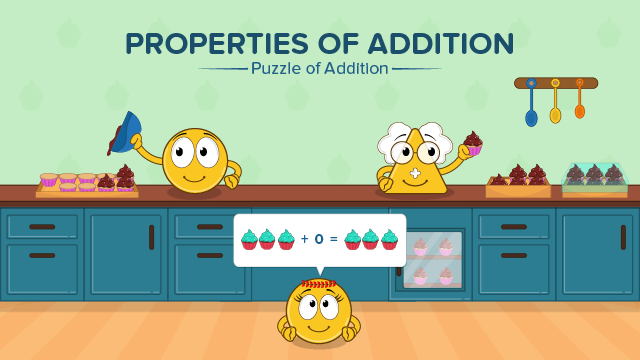
Math Story : Associative property of addition
Who can Count Faster?
“You have to play with us”, says Squarho and Cirho. “Children, I have a lot of pending work. Why don’t you go outside and play?” suggests Uncle Math. But both of them deny and force him to play with them.
“Hmm! I can take their help in completing my task”, thinks Uncle Math. “Alright! I need help in finding the total marbles that are required for my next assignment. Will you help me in finding this?” he says. Of course, Cirho and Squarho immediately agree.
Uncle Math goes and gets some jars filled with marbles. He places them on the table and says, “Let us make this more exciting. I will give 3 jars to each one of you. One who finds the total marbles the fastest will be rewarded with a cupcake”, he says. Cake and food are Squarho’s favourites. He is thrilled.

As discussed, both of them get 3 jars. “Ready, steady, go!” announces Uncle Math. Immediately, Cirho opens the first jar and starts counting. Whereas, Squarho is still looking at the jars and observing. But what?
“This last jar has fewer marbles than the other two. I should count these marbles first and then add it with the marbles from other jars”, plans Squarho. He opens the last jar and starts counting the marbles. On the other hand, Cirho has finished counting the marbles in the first jar.
Squarho is counting the marbles of the second jar now. Cirho is counting his third jar. Who will find the total marbles first?
“6 marbles in Jar 1, 8 in Jar 2 and 2 in Jar 3”, murmurs Squarho. Suddenly, he smiles. Has he got the answer? “16! There are 16 marbles in total,” he says. Wow! That was super fast. Cirho is still counting and is shocked to see this.

“16! There are 16 marbles in total in my jars as well”, says Cirho. What a coincidence! There was an equal number of marbles in the jars, so how did Squarho count so fast? Did he cheat? Or Does he know any trick? Let us find out.
“We had the same number of marbles to count. How did you count so fast?” says Cirho. He is disappointed. “Because I planned my ideas before starting to count. I first counted the marbles in individual jars. Then added them to find the total”, flaunts Squarho proudly.
“I did the same! There were 6, 8 and 2 marbles in my jars too. So I added 6 and 8 first. Then added 2 to the result”, explains Cirho. “I did it differently, Cirho. Adding 8 and 2 was easier than adding 6 & 8. So adding 8 and 2 gave me 10. Then combined 6 with the result. The final answer is 16. Wasn’t this faster?” explains Squarho.

“Cheating! This is wrong! We should always add the numbers in left to right order only”, screams Cirho. “No! I did not cheat!” screams Squarho. This leads to a fight. Only Uncle Math can help now!
“Stop it!” screams Uncle Math. “Squarho is right too! Whenever we add 3 or more numbers. We can group them in any combination. The result will not change. This is because of the Associative Property of addition”, he says. Cirho is sad.
Uncle Math apologizes to Cirho for being rude. He then explains, “There were 6, 8 and 2 marbles in your jars. Cirho added 6 and 8 first and then 2. He got 16 as the answer. Whereas, Squarho added 8 and 2 first and then 6. That was faster because adding any number to 10 is easier right?”

Clearly. Grouping the numbers in any order works well in addition. Cirho realizes his mistake too. He apologizes as well. Since Squarho is the winner, he gets a delicious cupcake as a reward.
“This cupcake would taste even better when you eat it with me”, says Squarho. Cirho immediately smiles. Squarho’s big heart and good planning skills are his strengths. Do you agree?
We Learnt That…
- The associative property of addition says that when we add 3 or more numbers, we can group them in order. The result would not change.
- Associative property helps us add the numbers faster.
- It is good to plan your next steps beforehand.
- A well-planned path to a goal makes the journey smooth.
Let’s Discuss
- How did Uncle Math engage Cirho and me?
- Who won the reward? Why?
- What does the associative property of addition state? Explain with an example.
- I planned my steps before starting to count. Should we do that too every time we perform a task?


